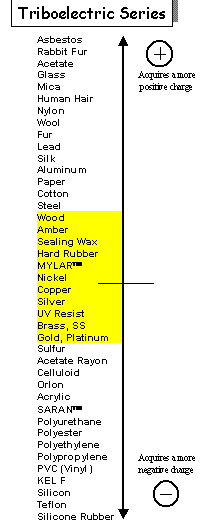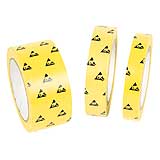 |
| ESD Technical e-Newsletter |
|

|
April 2000
Issue 4, Volume 3
|
|
TRIBOELECTRIC SERIES
| |
There are 3 common ways to generate static electricity, triboelectric generation, field induction, and direct charging. Triboelectric generation (tribocharging) is the most prevalent method for charge generation that needs to be well understood to control properly. The Triboseries is illustrated in the graph below and will help give you a better understanding this phenomena. Tribocharging can occur on both insulators and conductors.
A listing of materials, with respect to the polarity and magnitude of charge generated during contact and separation is called the Triboelectric Series. The series is arranged so that those materials at the top of the list lose electrons and charge positively when rubbed with materials below them relative to the Series. Conversely, the materials at the bottom of the list gain electrons and charges negatively. The farther away the materials are from each other within the list, the greater the magnitude of the charge is generation by them under tribocharging conditions.
The series should be considered a guide to both polarity and relative charge magnitude for various materials. Frequently, one finds some slight inconsistencies in magnitude between two materials from what the Series indicates. Sometimes complete reversals of material positions have been observed.

The most common example of tribocharging is a person walking across a floor. Depending on the materials involved, i.e., soles of the shoes (leather, rubber, wood, etc.) and the surface of the floor (nylon or wool carpet, vinyl tiles, cement, wood, polyurethane, etc.) the resulting charge on the shoes and balancing charge on the body will be dependent on the charge accumulation from area, frequency and contact force of the contact and separation (triboelectric generation) process. Voltages as high as 5kV at 40% RH were reported on a person after walking across vinyl flooring which can certainly be felt when discharging to a metal object (doorknob).
 To help further illustrate the triboelectric generation process, we can use a pair of ESD Training Paddles, one made from aluminum and the other from acrylic. You can see from the triboseries chart, that the acrylic paddle will acquire a more negative charge and the aluminum paddle will acquire a more positive charge when brought into contact and separated. There are several experiments you can perform to demonstrate triboelectric charging and electric fields all found within our Training Paddles Tech Brief PS-2029.
To help further illustrate the triboelectric generation process, we can use a pair of ESD Training Paddles, one made from aluminum and the other from acrylic. You can see from the triboseries chart, that the acrylic paddle will acquire a more negative charge and the aluminum paddle will acquire a more positive charge when brought into contact and separated. There are several experiments you can perform to demonstrate triboelectric charging and electric fields all found within our Training Paddles Tech Brief PS-2029.
|
|
|
|
New! Yellow ESD Tape w/symbols (Item # 16155-8)

- Identification or marking product / paperwork / processes
- High visibility yellow color with ESD susceptibility symbol for increased awareness
- Attach ESD paperwork to bags or product
- Ideal in packaging for container sealing, static shielding bag closure and holding IC DIP tubes
- Prevents damage to sensitive electronic components in manufacturing
|
New Improved Deluxe Combo Tester (Item # 41204)

- User touch plate, LED displays test results, positive switching; will not deform or bend from pushing; will not stick
- Black Case, differentiates from older units
- Rocker-switch, eliminates faulty installation of banana jack and faulty readings
- Dual test circuits - versatile, can test footwear or wrist straps
- Simple operation with clear test result
- Red light and audible indicator mean circuit resistance is too high or low
- Auto-ranging circuitry automatically selects proper test range
- Low battery indicator provides early warning to replace battery
- Optional AC adapter available
|
|
|
|
ESDA NE Chapter's Regional Tutorial Program Click here for more details
May 15th and 16th at the Boston University Conference Center in Tyngsboro, MA
- "ESD Basics" by Lou DeChiaro, Lucent Technologies
- "ESD Audits" by Larry Fromm of Hewlett Packard
- Panel Discussion on "ESD Common Myths"
|
|
|
|
Q1: Static charges are a real problem in the printing industry. Paper picks up a charge when run through the press. When the same paper is rerun through the press, it has enough charge in the paper to make it try to stick together creating a real feed problem. Do you have any experience in this area?. - Anonymous, Houston, TX ANSWER 1
Q2: Could you please provide a simple (non-scientist) definition of "tribocharge" and info. about tribocharge applications that either makes use of it or combat it? - Anonymous, E. Greenwich, RI ANSWER 2
Q3: Can dry (<20%rh) neon gas slowly passing over polyurethane coated electronics modules generate a static charge in the polyurethane? The module construction is polyimide MLBs laminated to an aluminum frame. The frames are tied to chassis ground and the neon is always in contact with chassis ground. - Anonymous, Cambridge, MA ANSWER 3
Q4: If an operator is wearing a 270K wrist strap, conductive shoes or foot straps and is working in an area with conductive flooring and conductive bench tops, what is the maximum potential the operator could be expected to achieve? - Anonymous, York, PA ANSWER 4
Find more ESD Q&A here
|
|
|
|
|
|
|
New 20.20 Electrostatic Discharge Control Program Standard Published
The ESD Association has approved and published a new standard covering the development of an ESD control program. Approved as an ANSI standard, ANSI/ESD S20.20-1999: Development of an Electrostatic Discharge Control Program covers the requirements necessary to design, establish, implement, and maintain an ESD control program to protect electrical or electronic parts, assemblies and equipment susceptible to ESD damage from Human Body Model (HBM) discharges greater than or equal to 100 volts.
Developed in response to the Military Standardization Reform Act, the new 20.20 is intended to be the commercial replacement for MIL-STD-1686. However, the Department of Defense has yet to act on the document.
Download it free of charge in PDF format (129K) for viewing with Adobe's Acrobat Reader.
|
|
|
This is a free monthly newsletter, which specializes on issues in static control in the semiconductor/electronics workplace and is best viewed while connected to the Internet.
Let us know what you think. Tell us what you would like to see in future issues. Want to contribute articles or other related information to our Newsletter? If you have any comments, suggestions or feedback about this newsletter, please send them directly to the editor@esdsystems.com, thanks.
|
|
|
Copyright © 2000 ESD Systems.com. All rights reserved.
|
|